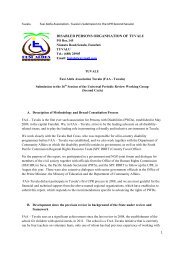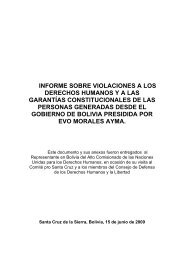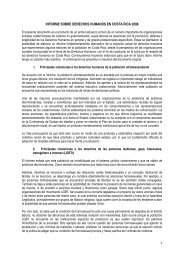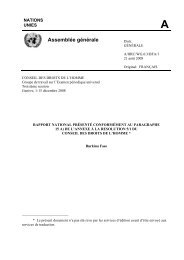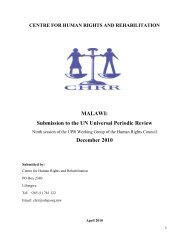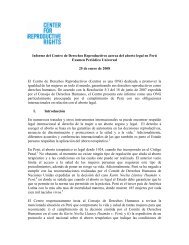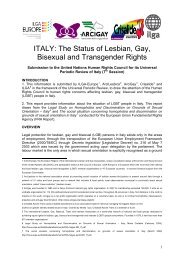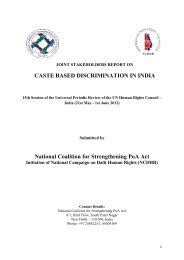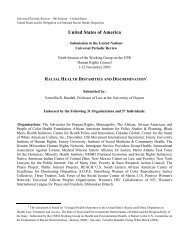Prison Needle Exchange: Lessons from a Comprehensive Review ...
Prison Needle Exchange: Lessons from a Comprehensive Review ...
Prison Needle Exchange: Lessons from a Comprehensive Review ...
Create successful ePaper yourself
Turn your PDF publications into a flip-book with our unique Google optimized e-Paper software.
punished by prison staff for accessing the program, and that the program provided a useful<br />
tool to reach prisoners with health-promotion messages and to refer them to other health programs.<br />
They also suggested that some flexibility was necessary in the program, in that a strict<br />
one-for-one exchange policy was not always practical. This issue was debated in the monitoring<br />
committee. The non-governmental organization staff argued in favour of flexibility<br />
regarding this policy. Their principle concern was that they did not want to deny a sterile needle<br />
to prisoners who injected drugs and who did not have a needle to exchange, since this<br />
would place the prisoner in a situation where he would be forced to share needles. The prison<br />
guards, however, were concerned with security issues. In the end, an 80% return rate was<br />
agreed as an acceptable standard (the program’s return rate was 82%).<br />
Evaluations of the other pilot projects were also positive. In discussing the experience of<br />
nine prison needle exchanges, a 2001 report prepared by the National Plan on Drugs noted<br />
that “[t]hese experiences have shown that these programmes can be reproduced in a penitentiary<br />
environment without resulting in any distortion or direct problems.” 195 The 2002 document,<br />
<strong>Needle</strong> <strong>Exchange</strong> in <strong>Prison</strong>: Framework Program, provided the following conclusions<br />
concerning the evaluations of Spanish prison syringe exchange programs: 196<br />
• Implementation of a NEP, as in the community outside prisons, is feasible and adaptable<br />
to the conditions of execution of the prison sentence.<br />
• NEPs in prison, as in the community outside prisons, produce behavioural changes<br />
that lead to a reduction in the risks associated with injection drug use.<br />
• NEPs in prison facilitate referral of users to drug addiction treatment programs.<br />
• Implementation of a NEP does not generally cause an increase in drug use or, specifically,<br />
an increase in parenteral heroin or cocaine use.<br />
• A NEP in prison should operate with a certain degree of flexibility and be tailored to<br />
the individual circumstances of each prisoner, but without for-<br />
getting the conditions for implementation established in each<br />
program.<br />
• It is feasible for a NEP and other drug addiction prevention or<br />
intervention programs to coexist.<br />
It is always preferable to find<br />
a way to provide prisoners<br />
who injects drugs with a<br />
sterile needle than force<br />
them into a position<br />
where they will share.<br />
The Spanish experience of prison syringe exchange has also found<br />
that levels of intravenous drug use have remained unchanged, there<br />
have been no accidental needle-stick injuries, there has been no<br />
increase in conflict among prisoners or between prisoners and staff,<br />
there have been no instances of syringes being used as weapons, and<br />
staff support for the programs has grown with the experience of implementation. 197<br />
Now that prison needle exchange has been expanded nationally, guidelines for ongoing<br />
evaluation have been developed as part of the Framework Program. A computer software<br />
package called SANIT is used in each prison to record the number of users of the program,<br />
number of syringes supplied and returned, enrolments/withdrawals <strong>from</strong> the program, and<br />
reasons for withdrawals. Health status is also included. To maintain the confidentiality of the<br />
program users, a randomly generated number or pseudonym is used to identify each participant.<br />
In addition to quantitative data, the evaluation also includes qualitative feedback <strong>from</strong><br />
prisoners and staff. Standard anonymous questionnaires for collecting this data are included<br />
within the Framework Program document. It is suggested that evaluations be done on at least an<br />
annual basis, if not more regularly (ie, three-, six-, and 12-month intervals). As a result, ongoing<br />
evaluation and assessment of the programs will be available annually on a national basis.<br />
<strong>Review</strong> of International Evidence 35



